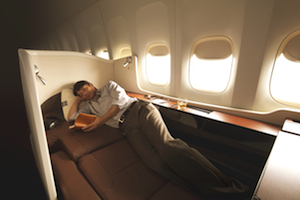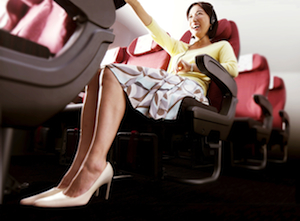It has been a fascinating few years for Japan Airlines (JAL) as it has weathered storms both natural and financial. The airline has emerged in a strong position though, exiting bankruptcy and announcing a 2012 profit forecast of ¥140 billion (US$1.7 billion), due in part to a savage cost-cutting scheme that saw the redundancy of a third of its global staff, as well as its entire fleet of 747s. To mark a return to its core values, including a return to the Tokyo Stock Exchange with 2012’s second-biggest IPO, the tsurumaru livery has come back, with the crane signifying loyalty and strength. And loyal JAL customers will soon enjoy a strong new product onboard the international fleet of 13 777-300ERs, designed to lure customers from rival airlines.

This comprehensive retrofit scheme is known as ‘Welcome! JAL New Sky’, with the specific 777 programme created under the title ‘JAL Sky Suite 777’. It launched in January 2013 on the Narita-to-Heathrow route, with subsequent retrofits rolling out at the rate of one a month. The design was created by Tokyo-based GK Industrial Design and was influenced by frequent traveller and award-winning Japanese author and screenwriter Kundo Koyama, who provided insights and opinions from a customer’s perspective. The ethos behind the scheme is that each class should not just be improved, but should feel like an upgrade to a class above.
Suite success
Even regular JAL first-class passengers will not recognise the new cabin, with eight JAL Suites arranged in a 1-2-1 configuration. These are the Venus model from Contour, with the walls in pale cream and white to brighten the cabin, the seats covered in a brown leather and the cabinetry in a warm woodgrain to evoke a bedroom feeling. The bed length is 78.5in, and at 33in wide it is around 4in narrower than the standard Venus model. The optional door was not selected in order to aid access for personal service, and an electrically retractable divider gives those in the middle seats the option of being sociable or private. When passengers want to sleep, the crew place a Tempur foam mattress and pillow on top of the bed and supply a duvet.
 There is plenty of stowage, with room for a cabin bag under the ottoman and multiple compartments to the side, one of which is large enough to accommodate a briefcase.
There is plenty of stowage, with room for a cabin bag under the ottoman and multiple compartments to the side, one of which is large enough to accommodate a briefcase.
While many airlines are leaving the massage function as an unchecked option on seat orders in order to save weight, it is an important part of Japanese culture and therefore features in the 777’s first and business-class seats. A new offering of ‘mini massagers’ is also soon to be launched. These devices can be attached to a passenger’s legs or arms for a localised massage, with five stowed on each aircraft and available to all classes.
Big business
Moving rearwards, there are 49 business-class JAL Sky Suites, which again mark a massive step up from the outgoing product – indeed the product exceeds its brief, actually being superior to the previous first class. The previous seat, the JAL Shell Flat Seat, reclined to only 170° and had little privacy. The new seat, from B/E Aerospace, offers a fully flat bed in a private mini-suite, arranged 2-3-2, all with direct aisle access. The only downside is that JAL loses 14 seats with the new configuration.
 Business travellers lose out little to those in first class, with a bed length of 74in, though it is narrower at 25.5in. In seat mode the width is 21in, but the armrest retracts and is covered in soft, padded leather to aid comfort when lying down. Prior to sleeping, the crew add a new product – an S-Line mattress and pillow from Weava Japan. These items are made from a very fine woven fibre resin called Airweave, which looks similar to bubblewrap, and supports the contours of the body to aid sleep, while also helping control body temperature. A duvet finishes off the experience.
Business travellers lose out little to those in first class, with a bed length of 74in, though it is narrower at 25.5in. In seat mode the width is 21in, but the armrest retracts and is covered in soft, padded leather to aid comfort when lying down. Prior to sleeping, the crew add a new product – an S-Line mattress and pillow from Weava Japan. These items are made from a very fine woven fibre resin called Airweave, which looks similar to bubblewrap, and supports the contours of the body to aid sleep, while also helping control body temperature. A duvet finishes off the experience.
As the centre seats offer the most privacy, with a solid electronic divider screen on each side, JAL predicts that they will be the most popular choice for overnight flights, especially since they feature direct aisle access. However, access to overhead bins is more difficult and there is no side table, unlike neighbouring seats. There is still ample stowage space, though, with room for a cabin bag under the ottoman. Window and centre seats also benefit from a stowage shelf on top of the seat shell, and a monitor table.
The feeling in the business seat is again domestic, with a mulberry-coloured seat fabric woven by TB Kawashima. The rear of the pod is finished in a mushroom suede-effect fabric, while the monitor surround and swivel table are clad in a pale woodgrain veneer.
Strong economy
 The premium economy product is generous, with the 40 seats, configured 2-4-2, benefitting from a 19in width and 42in pitch – 4in more pitch than the previous JAL Sky Shell Seat, though four seats were sacrificed. The fixed-shell design, actually a Sicma business-class model, allows 7cm of seat slide and has a large legrest and three-stage adjustable footrest. There is a small centre divider for privacy, an armrest wide enough to prevent elbow fights, a coat hook, a seatback table large enough for an A4-size laptop, as well as a complementary USB port, video input and AC power outlet.
The premium economy product is generous, with the 40 seats, configured 2-4-2, benefitting from a 19in width and 42in pitch – 4in more pitch than the previous JAL Sky Shell Seat, though four seats were sacrificed. The fixed-shell design, actually a Sicma business-class model, allows 7cm of seat slide and has a large legrest and three-stage adjustable footrest. There is a small centre divider for privacy, an armrest wide enough to prevent elbow fights, a coat hook, a seatback table large enough for an A4-size laptop, as well as a complementary USB port, video input and AC power outlet.
This is a key product, as JAL is keen to attract the many business travellers whose travel budgets no longer stretch to business-class tickets, but still want to enjoy some comforts. As a further incentive, premium-economy passengers can also access JAL’s business-class airport lounges, as well as having their own cabin and dedicated cabin crew.
Low cost, high comfort
 Configured 3-3-3, the new economy cabin features 135 JAL Sky Wider seats from ZIM Flugsitz at a 33-34in pitch – a major increase from the previous 31in. Seat width also has been increased by 0.8in more than the previous Koito model, bringing it to 18.5in. A slimmed-down seatback also affords an extra 1.2in of knee space, with further comforts including a netted bottle holder and a smartphone holder near the USB port.
Configured 3-3-3, the new economy cabin features 135 JAL Sky Wider seats from ZIM Flugsitz at a 33-34in pitch – a major increase from the previous 31in. Seat width also has been increased by 0.8in more than the previous Koito model, bringing it to 18.5in. A slimmed-down seatback also affords an extra 1.2in of knee space, with further comforts including a netted bottle holder and a smartphone holder near the USB port.
Further space was created by making the armrest design thinner. They also fold flush so that passengers with children, or perhaps larger passengers, can spread out a little, especially since the seatpads are flat.
Entertainment
All classes of passengers can enjoy the Thales TopSeries IFE system, as also found on JAL’s 787. First and business-class passengers have 23in touchscreens – an increase of 4in in first and 7.6in in business – and also benefit from Thales’ Touch Passenger Media Units (TouchPMUs), an Android-based handset with a 3.8in LCD screen that can be used independently of the main screen to watch the moving map, for example.
Premium economy passengers get 12.1in personal touch-panel TV screens (35% wider than the previous product), while economy passengers watch a 10.6in touchscreen, both twinned with a more traditional handset with buttons for selecting functions and gaming on the front, and a qwerty keyboard on the back.
All classes can choose content from 50 channels, with the unique Sky Manga e-comic function as launched on the 787’s system to follow. Inflight internet, called JAL Sky Wi-Fi and found on other routes, will soon follow on the 777 fleet.
Beyond the system itself, JAL is looking at signing up for TopCare, a turnkey maintenance programme, under which the management of every aspect of the in-flight entertainment systems will be taken care of by Thales.
Feeling peckish?
January 2013 also saw the launch of the JAL BEDD – Sky Auberge first and business-class meal service, created by a team of prominent chefs and tailored to specific routes. Premium economy and economy passengers are offered more basic dishes from the JAL Kitchen Gallery, with some routes featuring the AIR Series meals that JAL offers in collaboration with well-known Japanese restaurants and eateries. These meals include Air Taimeiken, a fluffy omelette rice dish, Air Yoshinoya, a traditional beef bowl, and the MOS Burger with rice bun. Additionally, exclusive to premium economy customers, champagne, Dean & Deluca ice-cream and mousse, and Toronama Donuts will also be available on applicable routes. A special meal is also soon to launch – KFC.
Upstaged?
The 777 product is certainly a compelling offer, but curiously it is also superior to the newly launched cabins on JAL’s flagship 787s. Recognising this, the airline also plans to retrofit its 787s with the Sky Suite product.
The airline is being tight-lipped about the cost of the programme, given its recent financial troubles, but the investment could be enough of a draw for passengers to see JAL’s profit forecasts soar even higher.




